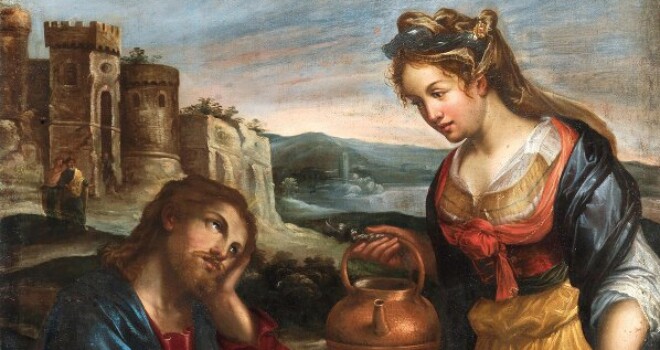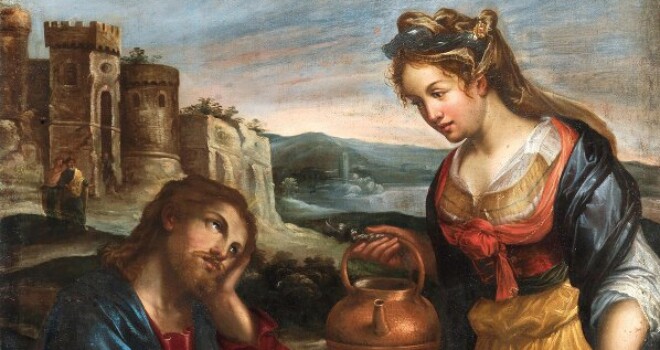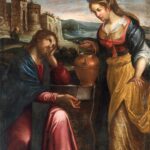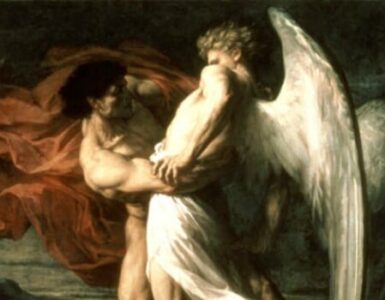Viewing and pondering sacred art, engaging in vizio divina, offers the faithful a great way to meditate more deeply on the life of Jesus Christ and the mystery of salvation. This series of articles will highlight several pieces of art related to the season of Lent, specifically the Gospel readings for each week. Each of these pieces of art allows us to reflect on the transformation to which our Lord calls us during this penitential season, and to bring the realities of these biblical episodes into our own lives.
On the Third Sunday of Lent, in Year A of our Church’s lectionary cycle, we hear the story of the Samaritan woman who was met by Jesus at Jacob’s well. This Gospel is used for the first scrutiny of the unbaptized catechumens who are in their final stages of preparation for initiation into the Catholic faith. It is employed at this moment of the liturgical year because it is a story of an astonishing divine encounter, when the Messiah broke through social customs and religious norms to bring Living Water to a thirsty soul.
Christ and the Woman of Samaria is a memorable depiction of this biblical event from the early-1600s. It is memorable primarily for its artistic acumen, but it is also memorable because it was painted by a woman, Lavinia Fontana. The various aspects of the art world in Fontana’s time and place were dominated almost completely by males, so she is generally regarded as the first female to make a career of art. Both the artist and her depiction of this biblical episode teach us to look well beyond existing norms and expectations, and to look for a deeper message of truth, goodness, and beauty.
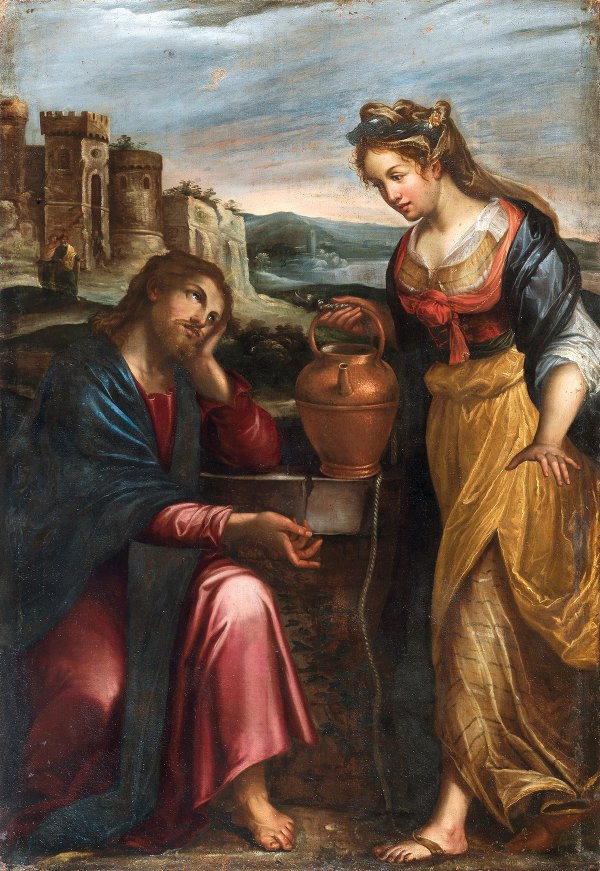
In the biblical narrative, we hear that Jesus was “tired from his journey [and] sat down there at the well” (Jn. 4:6). In Fontana’s depiction, Jesus’ weariness is apparent on his face but he still looks at this Samaritan woman whom he has come to meet in this divine appointment. Realizing this dynamic, do we ask ourselves: Do I recognize that Jesus still looks at me and longs to meet me in a divine encounter, regardless of my sin or my current condition?
As we turn our eyes with Jesus toward this woman, we notice a few things about her appearance and her gestures that provide invitations for reflection. First, the woman’s hair is particularly unkempt. Such a lack of styling reminds us of someone who is preoccupied with other worries and tasks. This particular detail might cause a viewer to ask: What are the worries and tasks that consume my attention? Does my attention to those things cause me to neglect other necessary tasks, or even my appearance? Is a divine encounter something I need or want in order to change this pattern?
In addition to her hair, the woman’s clothing invites consideration. Her wardrobe on this day by the well is eclectic. She has several layers, none of which match any of the others. This could indicate her preoccupation with other matters, but it might also symbolize her lack of peace and wholeness. Yet we notice that there is at least a small bit of red trim, the color of love and charity. This shows us that all persons have the potential to engage in an exchange of loving charity with others.
We also notice that her wardrobe stands in stark contrast to Jesus’ wardrobe, which is simple and understated, yet complete and ordered. His dress garment is also completely red, indicating that he shows us the perfection of love and charity. One who gazes on clothing in the image might reflect on what causes disorder. How is my disorder manifested on the outside? How might Jesus want to give his order and peace to me? How much of my life is an expression of Jesus Christ’s love and charity?
The woman also holds the water jar that is such an iconic image in this episode. The long rope attached to the jug might also be symbolic of the many attachments that might have to be discarded in order to receive the Living Water that Jesus wants to give each of us. This is also the jug that the woman left behind when she went to the town to proclaim what the Lord had said and done (cf. Jn. 4:28-29). What does this jug tell me about my own attachments? How deep do those attachments go in my spirit? Am I willing to leave those attachments behind for a greater joy and peace through Jesus?
The woman’s left hand also makes an interesting point for reflection. Her fingers are spread wide, almost as if she is counting the number of husbands she has had in her life (cf. Jn. 4:16-19). In this still picture of the scene, the viewer can almost feel the woman jerking this hand away from Jesus as if to say, “No! I will keep control of this situation!” Yet, Jesus’ right hand provides another notable contrast. He gestures, as if to say, “Hand over to me the ways that those relationships have hurt you. Let me heal your deepest wounds.” This small detail of the painting allows any one of us to look into our own hearts: Am I keeping count of the things that have injured me? Do I recognize Jesus’ gentle hand asking me to hand those injuries over to him? Do I recoil from his request, thinking that I can manage and control such situations?
Over Jesus’ shoulder, two details from the scene elicit further reflection. Walking along the road, a pair of apostles is recognizable. They are returning from their mission to buy food, and they are the ones who did not understand why Jesus had made this divine appointment. When they urged him to eat, he told them of the food “of which you do not know,” fulfilling the will and work of the heavenly Father (Jn. 4:27, 32-34). Any disciple can continue to reflect: Am I following Jesus, completing the tasks he gives me? Are there times when I do not fully understand his intentions or methods? What helps me to understand more fully?
There is also the town that factors into this passage. It is the town to which the disciples went to purchase food. More importantly, it is the town that had ostracized the woman; and it is the town to which she hurried after she left her jar, saying to the townspeople, “Come, see a man who told me all that I ever did. Can this be the Christ?” (Jn. 4:29). Are there settings in my life from which I have felt cast out, perhaps family or work settings? Is the Lord, perhaps, preparing me in any way to abandon my comfort zones and approach that setting again? What will my message be in that setting: telling of bitter grudges, or telling of the Lord’s grace and healing? Am I willing to let the Divine Physician heal me by his Living Water of the bitterness and grudges that might have been in my heart?
Pondering Fontana’s painting reveals to us that this encounter between Jesus and the Samaritan woman provides a basic paradigm for the whole spiritual life. All of the questions for reflection that arise from the details of this painting should be pondered throughout the year, and especially during Lent. Engaging in such a fruitful examination of conscience helps to elicit the transformation that God wants for us during this holy season.


